Kentucky Pesticide Safety Education Program
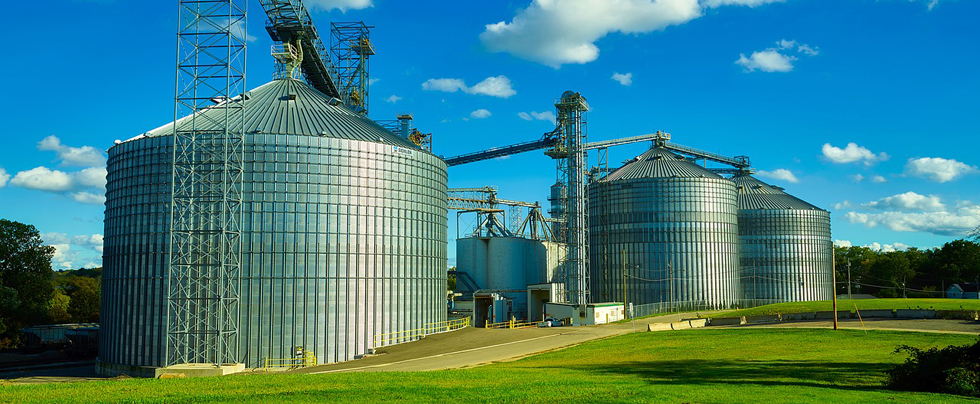
Questions?
Contact
Dr. Ric Bessin
Dept. of Entomology
University of Kentucky
859-257-7450
rbessin@email.uky.edu
Example Fumigants
Phosphine Gas
(Aluminum Phosphide, Magnesium Phosphide)
Phosphine is a mobile gas that can disperse to all parts of a storage structure or enclosure. This highly toxic gas kills animals and humans by disrupting respiration and metabolism. In addition, phosphine gas will corrode certain metals and may ignite spontaneously at concentrations above its lower flammable limit of 1.8% volume/volume (18,000 ppm).
Aluminum phosphide and magnesium phosphide are space, commodity, and rodent burrow fumigants. Formulations include pellets, tablets, prepacs, prepac ropes, bags, and plates. These solids react with moisture in the air to produce phosphine gas. The process starts slowly, gradually accelerates, and then slows as the product is spent.
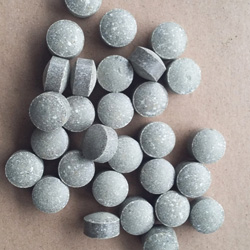
Phostoxin pellets (photo: ecvv.com)
The odor of this colorless gas has been described as similar to garlic or decaying fish. Formulations that include ammonium carbonate release carbon dioxide and ammonia. Carbon dioxide reduces the fire hazard, while ammonia is a warning agent. Phosphine is slightly (1.2 times) heavier than air so it will not move evenly through solid storage, such as a grain bin. One or more fans are need to mix the fumigant with air.
Magnesium phosphide also reacts faster with water to release phosphine gas but the process is faster than with aluminum phosphide. Consequently, magnesium phosphide products are formulated into strips or blankets that can be placed very quickly. This application method usually is not used to fumigate stored grain. However, magnesium-phosphide products effectively fumigate warehouses and processing plants. Since magnesium phosphide is more reactive, it can be used to fumigate under cooler and/or drier conditions.
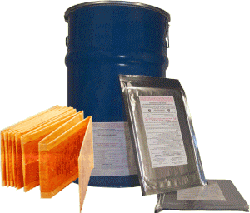
Magtoxin® sheeted stacks (photo: apolimantikiltf.gr)
A phosphine fumigation period must be long enough to provide adequate pest control and to allow for more or less complete reaction of the product with moisture in the air. Applicator and worker exposure is minimized if little or no unreacted phosphide remains.
The minimum length of the fumigation period varies with formulation and exposure conditions (see table below). Generally, insects are more difficult to control and the rate of phosphine gas production is reduced at lower temperatures and humidity.
| Temperature (°F) | Minimum exposure periods for aluminum phosphine (days) | |
|---|---|---|
Pellets |
Tablets |
|
40 |
Do not fumigate |
Do not fumigate |
41-53 |
8 |
10 |
54-59 |
4 |
5 |
60-68 |
3 |
4 |
Above 68 |
2 |
3 |
The fumigant dose is based on the total volume of the space being treated, not on the amount of commodity present. Lengthening the fumigation period will not increase insect control if the structure is not carefully sealed or if gas distribution is poor. Exposure periods in the table may not be adequate to control all stored products pests under all conditions, nor will they always provide for total reaction.
Some structures must be completely covered with tarpaulins for fumigation; those that cannot be properly sealed by any means should not be fumigated. Apply additional fumigant if phosphine concentrations drop below an effective level. Follow the requirements for the minimum number of workers and use proper respiratory protection if re-entry into the treated structure is required.
After decomposition, aluminum phosphide leaves a gray-white powder composed almost entirely of aluminum hydroxide and other inert ingredients. There is no problem with fumigant added directly to a commodity such as grain. However, spent powder must be retrieved for disposal after a space fumigation. If properly exposed, the spent fumigant will normally contain only a small amount of unreacted aluminum phosphide and may be disposed of without hazard.
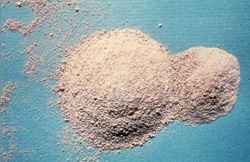
Spent fumigant powder (photo: Degesch America, Inc.)
Low humidity, cool temperatures, shortened exposure periods, or cases where more fumigant is added during the fumigation may result in partially spent material. This residue must be deactivated prior to disposal. Improper disposal of excess pesticide is a violation of Federal Law.
Personal Protection - Phosphine
Applicators should wear dry cotton gloves if contact with tablets, pellets, or dust is likely. The gloves should remain dry during use. Wash hands thoroughly after handling the product. Aerate potentially contaminated used gloves and other clothing in a well-ventilated area prior to laundering.
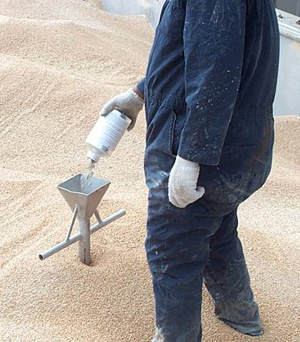
Wear dry cotton gloves if contact with product is likely
(photo: Degesch America, Inc.)
Respiratory protection is required when the concentration of phosphine in the air is unknown or if it exceeds the Permissible Exposure Limit (> 0.3 ppm). A NIOSH/MSHA approved full-face gas mask with a phosphine canister may be used at levels up to 15 ppm. An approved self-contained breathing apparatus (SCBA) must be worn if the concentration is above 15 ppm or if the phosphine concentration is unknown.
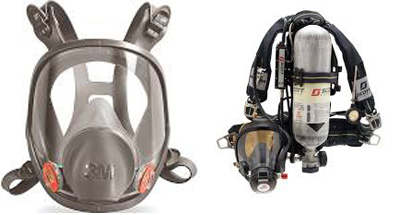
Full-face respirator (photo: ULINE) and SCBA (photo: Scott Safety)
Certified applicators must be present and are responsible for all workers
A Certified Applicator must be physically present, responsible for, and maintain visual and/or voice contact with all fumigation workers during:
1) the opening of the product containers and application. The applicator does not need to be physically present once the application is complete and the structure has been secured.
2) during the initial opening of the fumigated structure for aeration. The applicator does not need to be physically present once the aeration process is secured and monitoring has established that aeration can be completed safely. A trained person can complete the process and remove the placards.
3) Persons with documented training in the handling of phosphine products must be responsible for receiving, aerating, and removing placards from vehicles that have been fumigated in transit.
Gas Detection
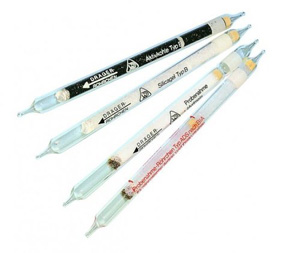
Gas detection devices
(photo: Gas Detection Warehouse)
Several gas detection devices can measure phosphine gas concentrations. Glass detection tubes used with the appropriate hand-operated air sampling pumps are widely used. These inexpensive devices are simple to use and provide accurate relatively rapid results. In addition, electronic devices are available for both low level and high phosphine gas readings.
Placarding of Fumigated Areas
Placards must be placed at all entrances to the fumigated structure. They must be able to withstand adverse weather conditions and must have the following wording:
The signal words DANGER/PELIGRO and the SKULL AND CROSSBONES symbol in red.
"Structure and/or commodity under fumigation, DO NOT ENTER/NO ENTRE".
"This sign may only be removed by a certified applicator or a person with documented training after the structure and/or commodity is completely aerated (contains 0.3 ppm or less of phosphine gas)".
If an incompletely aerated commodity is transferred to a new storage structure, the new structure must also be placarded if it contains > 0.3 ppm phosphine. Worker exposure during the transfer must not exceed allowable limits.
The date the fumigation begins.
Name and EPA registration number of fumigant used.
Name, address and telephone number of the Fumigation Company and/or applicator.
A 24-hour emergency response telephone number.
Leakage from Fumigated Sites
Phosphine gas is highly mobile. Given enough time, it may penetrate seemingly gas-tight materials. Check adjacent enclosed areas that may be occupied to ensure that significant leakage has not occurred. Sealing the fumigated site and/or increasing airflow in the occupied areas must be sufficient to bring down the phosphine concentration to a safe level (< 0.3 ppm).
Aeration and Re-entry
Aerate the fumigated structure before allowing anyone to enter. Be sure that gas leaving the treated commodity does not produce areas with unacceptable levels of phosphine. Do not allow anyone to re-enter treated areas until the level of phosphine reaches 0.3 ppm or below unless they are protected by an approved respirator.
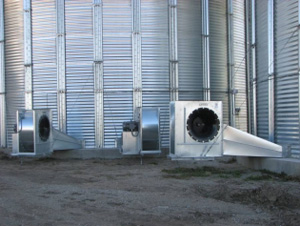
Bin aeration fan (photo: Feed&Grain.com)
[return]
Sulfuryl Fluoride
Sulfuryl fluoride (Vikane) is used to fumigate closed structures and their contents for drywood and Formosan termites, wood-infesting beetles, bed bugs, carpet beetles, clothes moths, cockroaches, and rodents. It breaks down in the insect's body to release fluoride, which interferes with the insect's ability to maintain energy. Without energy, the insect dies in a few days. Insect eggs are less susceptible to sulfuryl fluoride than other life stages.
Sulfuryl fluoride is a respiratory irritant that also affects the central nervous system of mammals and humans. It is non-flammable, non-corrosive, and does not react with materials to produce odors or residues. Although the gas is only slightly toxic by inhalation, it poses an acute hazard because it is odorless and colorless. For this reason, occupants must leave the structure before the fumigation begins and stay out until the gas is removed.
Sulfuryl fluoride gas is introduced into enclosed structures to fill all air spaces and to penetrate cracks, crevices, and pores in wood. It penetrates materials quickly and dissipates rapidly during ventilation. To be effective, the fumigant must be contained for a sufficient time; therefore, workers must place a tent around the structure during the fumigation. Sulfuryl fluoride is heavier (1.35 times) than air.
The warning agent chloropicrin (tear gas) must be released into the structure/ area to be fumigated at least 5 to 10 minutes before introduction of the fumigant.
Protective Clothing
Wear splash resistant goggles or full-face shield when handling the liquid fumigant during introduction or when working around any lines containing the fumigant under pressure. Do not wear gloves or rubber boots. Do not reuse clothing or shoes contaminated with the liquid fumigant until thoroughly aerated. Wear loose fitting or well-ventilated long-sleeve shirt, long pants, shoes and socks.
Respiratory Protection
Special monitoring equipment is needed to use sulfuryl fluoride. No respiratory protection is required if the gas concentration in the fumigated area, as measured by a suitable detection device, does not exceed 5 parts per million. If the minimum allowed concentration is greater than 5 ppm or is unknown, all persons in the fumigated area must wear a NIOSH or MSHA approved positive pressure self-contained breathing apparatus (SCBA) or combination air-supplied/SCBA. The SCBA must be on site and operational before fumigation.
[return]
Carbon Dioxide (CO2)
Carbon dioxide (CO2) makes up about 0.0004% in the air that we breathe. It is 1.5 times heavier than air. When used as a fumigant, its concentration must be increased to about 40%-60% of the air volume.
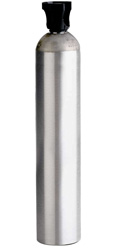
CO2 tank
(photo: GrowersHouse.com)
Structures fumigated with CO2 must be airtight and there must be a way for displaced air to escape. Consequently, CO2 usually is used in a facility designed for closed-loop fumigation. It has exchangers designed to remove air and introduce the fumigant, which is recirculated through the structure.
Fumigating with CO2 is generally safer than with other chemicals. However, a breathing apparatus is needed for re-entry into a structure during fumigation and for anyone who reenters a structure that contains levels of CO2 higher than 5% of the air volume. A SCBA (self-contained breathing apparatus) must be worn because canister gas masks do not work for CO2.
Even though CO2 does not leave a residue, there are concerns that it will change the flavor of products made from some fumigated vegetables, malting barley, or other porous grains.
[return]
1) The reaction to produce phosphine gas is most effective when humidity in the area to be treated is very low.
2) Which reacts faster with water to release phosphine gas?
3) Which can be used to fumigate under cooler, drier conditions because it is more reactive?
4) Phosphine gas is lighter than air.
5) Applicator and worker exposure to phosphine gas is minimized if ___________________.
- less that 25% of the phosphide has not reacted to release gas
- there is little or no unreacted phosphide left after the reaction
- over 50% of the phosphide has reacted to release gas
6) In general, the amount of phosphide needed to fumigate an enclosed structure _____________ as temperature increases.
7) A significant amount of unreacted/unspent aluminum phosphide may remain after a fumigation if _______________________.
- the temperature was high
- the humidity was high
- the exposure period was very long
- the exposure period was too short
8) __________ gloves should be worn if skin contact with a phosphide product is likely.
9) Respiratory protection is required when the concentration of phosphine in the air is unknown or if it exceeds the Permissible Exposure Limit of ___ ppm.
10) An approved self-contained breathing apparatus (SCBA) must be worn if the concentration phosphine concentration in the air is above ___ ppm or if it is unknown.
11) Sulfuryl fluoride CANNOT be used to control which of the following?
12) _____________ must be released into the area to be fumigated before sulfuryl fluoride is released.
13) A warning agent must be released into the area to be fumigated ________ before sulfuryl fluoride is released.
14) Gloves and rubber boots must be worn when handling sulfuryl fluoride.
15) No respiratory protection is required if the concentration of sulfuryl fluoride in the fumigated area DOES NOT exceed 5 parts per million.
16) CO2 is such a safe fumigant that no breathing apparatus is needed for re-entry during fumigation.
17) A canister-type gas mask does not protect a fumigator from CO2.
website content by L. Townsend website design by P. Dillon copyright © 2016 University of Kentucky Department of Entomology
University of Kentucky College of Agriculture |
S-225 Agricultural Science Center North, Lexington, KY 40546-0091 | 859.257.7450
An Equal Opportunity University |
Last modified
11/30/2018
